Denon AVR-3801 User Manual
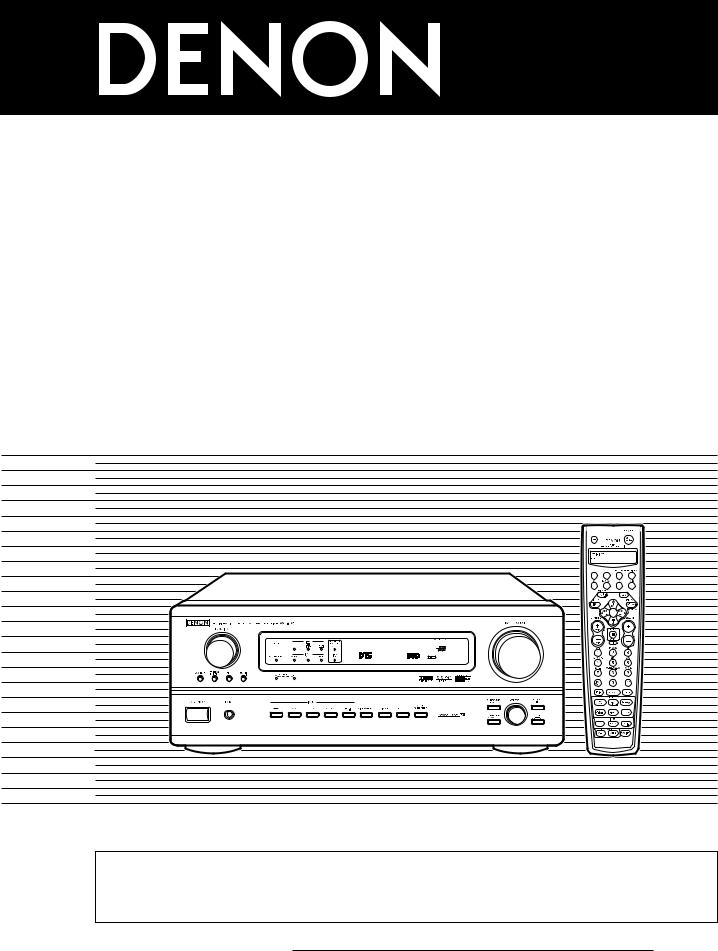
AV SURROUND RECEIVER
AVR-3801
OPERATING INSTRUCTIONS
2We greatly appreciate your purchase of the AVR-3801.
2To be sure you take maximum advantage of all the features the AVR-3801 has to offer, read these instructions carefully and use the set properly. Be sure to keep this manual for future reference, should any questions or problems arise.
“SERIAL NO.
PLEASE RECORD UNIT SERIAL NUMBER ATTACHED TO THE REAR OF THE CABINET FOR FUTURE REFERENCE”
1 |
1 |
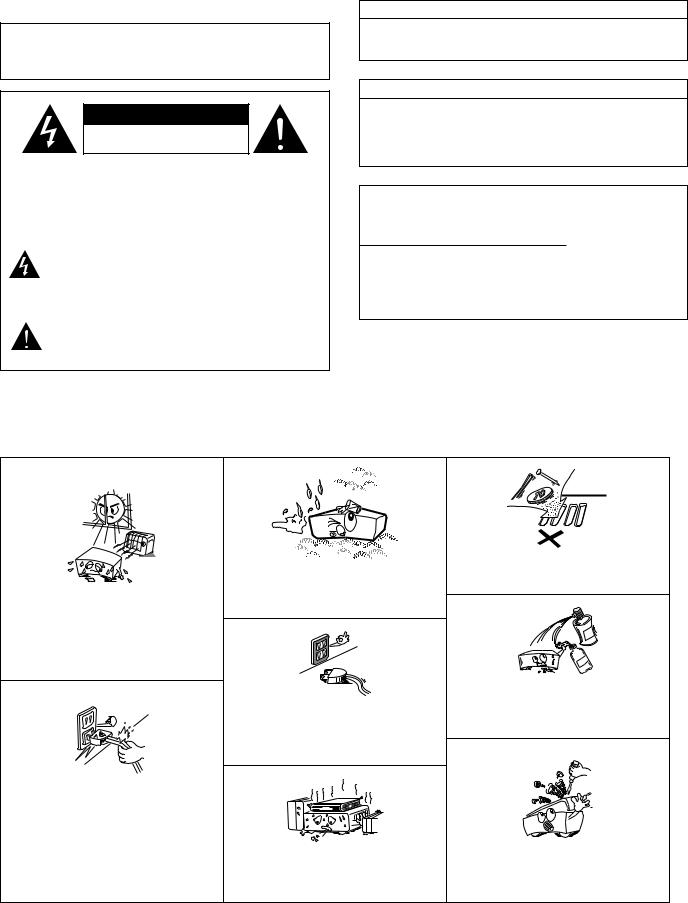
2SAFETY PRECAUTIONS
WARNING:
TO PREVENT FIRE OR SHOCK HAZARD, DO NOT EXPOSE THIS APPLIANCE TO RAIN OR MOISTURE.
CAUTION
RISK OF ELECTRIC SHOCK
DO NOT OPEN
CAUTION: TO REDUCE THE RISK OF ELECTRIC SHOCK, DO NOT REMOVE COVER (OR BACK). NO USERSERVICEABLE PARTS INSIDE. REFER SERVICING TO QUALIFIED SERVICE PERSONNEL.
The lightning flash with arrowhead symbol, within an equilateral triangle, is intended to alert the user to the presence of uninsulated “dangerous voltage” within the product’s enclosure that may be of sufficient magnitude to constitute a risk of electric shock to persons.
The exclamation point within an equilateral triangle is intended to alert the user to the presence of important operating and maintenance (servicing) instructions in the literature accompanying the appliance.
CAUTION
TO PREVENT ELECTRIC SHOCK, MATCH WIDE BLADE OF PLUG TO WIDE SLOT, FULLY INSERT.
ATTENTION
POUR ÉVITER LES CHOCS ÉLECTRIQUES, INTERODUIRE LA LAME LA PLUS LARGE DE LA FICHE DANS LA BORNE CORRESPONDANTE DE LA PRISE ET POUSSER JUSQU’ AU FOND.
This device complies with Part 15 of the FCC Rules. Operation is subject to the following two conditions: (1) This device may not cause harmful interference, and (2) this device must accept any interference received, including interference that may cause undesired operation.
This Class B digital apparatus meets all requirements of the Canadian Interference-Causing Equipment Regulations.
Cet appareil numérique de la classe B respecte toutes les exigences du Règlement sur le matériel brouilleur du Canada.
2NOTE ON USE / OBSERVATIONS RELATIVES A L’UTILISATION
•Avoid high temperatures.
Allow for sufficient heat dispersion when installed on a rack.
•Eviter des températures élevées
Tenir compte d’une dispersion de chaleur suffisante lors de l’installation sur une étagère.
•Handle the power cord carefully.
Hold the plug when unplugging the cord.
•Manipuler le cordon d’alimentation avec précaution.
Tenir la prise lors du débranchement du cordon.
•Keep the set free from moisture, water, and dust.
•Protéger l’appareil contre l’humidité, l’eau et lapoussière.
•Unplug the power cord when not using the set for long periods of time.
•Débrancher le cordon d’alimentation lorsque l’appareil n’est pas utilisé pendant de longues périodes.
*(For sets with ventilation holes)
•Do not obstruct the ventilation holes.
•Ne pas obstruer les trous d’aération.
•Do not let foreign objects in the set.
•Ne pas laisser des objets étrangers dans l’appareil.
•Do not let insecticides, benzene, and thinner come in contact with the set.
•Ne pas mettre en contact des insecticides, du benzène et un diluant avec l’appareil.
•Never disassemble or modify the set in any way.
•Ne jamais démonter ou modifier l’appareil d’une manière ou d’une autre.
2

SAFETY INSTRUCTIONS
1.Read Instructions – All the safety and operating instructions should be read before the appliance is operated.
2.Retain Instructions – The safety and operating instructions should be retained for future reference.
3.Heed Warnings – All warnings on the appliance and in the operating instructions should be adhered to.
4.Follow Instructions – All operating and use instructions should be followed.
5.Water and Moisture – The appliance should not be used near water – for example, near a bathtub, washbowl, kitchen sink, laundry tub, in a wet basement, or near a swimming pool, and the like.
6.Carts and Stands – The appliance should be used only with a cart or stand that is recommended by the manufacturer.
6A. An appliance and cart combination should be moved with care. Quick stops, excessive force, and uneven surfaces may cause the appliance and cart
combination to overturn.
7.Wall or Ceiling Mounting – The appliance should be mounted to a wall or ceiling only as recommended by the manufacturer.
8.Ventilation – The appliance should be situated so that its location or position does not interfere with its proper ventilation. For example, the appliance should not be situated on a bed, sofa, rug, or similar surface that may block the ventilation openings; or, placed in a built-in installation, such as a bookcase or cabinet that may impede the flow of air through the ventilation openings.
9.Heat – The appliance should be situated away from heat sources such as radiators, heat registers, stoves, or other appliances (including amplifiers) that produce heat.
10.Power Sources – The appliance should be connected to a power supply only of the type described in the operating instructions or as marked on the appliance.
11.Grounding or Polarization – Precautions should be taken so that the grounding or polarization means of an appliance is not defeated.
12.Power-Cord Protection – Power-supply cords should be routed so that they are not likely to be walked on or pinched by items placed upon or against them, paying particular attention to cords at plugs, convenience receptacles, and the point where they exit from the appliance.
14.Cleaning – The appliance should be cleaned only as recommended by the manufacturer.
15.Power Lines – An outdoor antenna should be located away from power lines.
16.Outdoor Antenna Grounding – If an outside antenna is connected to the receiver, be sure the antenna system is grounded so as to provide some protection against voltage surges and built-up static charges. Article 810 of the National Electrical Code, ANSI/NFPA 70, provides information with regard to proper grounding of the mast and supporting structure, grounding of the lead-in wire to an antenna-discharge unit, size of grounding conductors, location of antenna-discharge unit, connection to grounding electrodes, and requirements for the grounding electrode. See Figure A.
17.Nonuse Periods – The power cord of the appliance should be unplugged from the outlet when left unused for a long period of time.
18.Object and Liquid Entry – Care should be taken so that objects do not fall and liquids are not spilled into the enclosure through openings.
19.Damage Requiring Service – The appliance should be serviced by qualified service personnel when:
A.The power-supply cord or the plug has been damaged; or
B.Objects have fallen, or liquid has been spilled into the appliance; or
C.The appliance has been exposed to rain; or
D.The appliance does not appear to operate normally or exhibits a marked change in performance; or
E.The appliance has been dropped, or the enclosure damaged.
20.Servicing – The user should not attempt to service the appliance beyond that described in the operating instructions. All other servicing should be referred to qualified service personnel.
FIGURE A
EXAMPLE OF ANTENNA GROUNDING
AS PER NATIONAL
ELECTRICAL CODE ANTENNA LEAD IN WIRE
GROUND
CLAMP
ANTENNA DISCHARGE UNIT
(NEC SECTION 810-20)
ELECTRIC
SERVICE
EQUIPMENT
GROUNDING CONDUCTORS (NEC SECTION 810-21)
GROUND CLAMPS
POWER SERVICE GROUNDING ELECTRODE SYSTEM
(NEC ART 250, PART H)
NEC - NATIONAL ELECTRICAL CODE
3
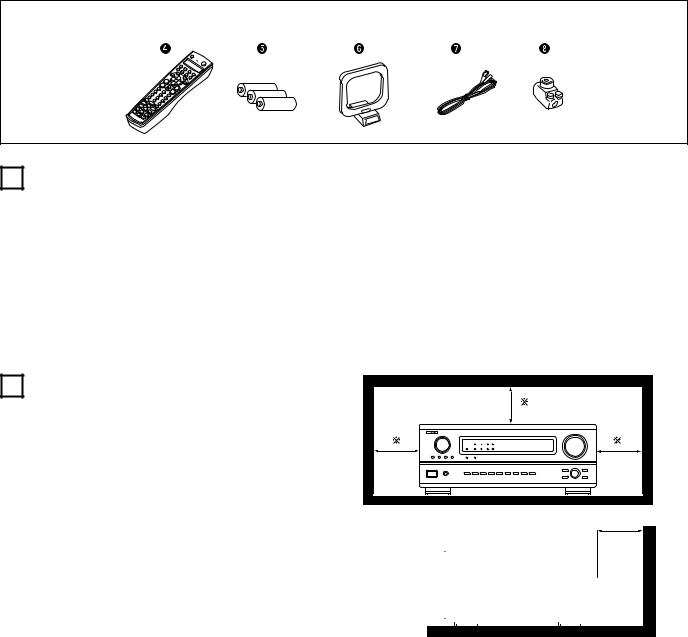
2INTRODUCTION
Thank you for choosing the DENON AVR-3801 Digital Surround A / V receiver. This remarkable component has been engineered to provide superb surround sound listening with home theater sources such as DVD, as well as providing outstanding high fidelity reproduction of your favorite music sources.
As this product is provided with an immense array of features, we recommend that before you begin hookup and operation that you review the contents of this manual before proceeding.
TABLE OF CONTENTS
z Before Using ............................................................................................... |
4 |
Ú0 Surround ............................................................................................. |
49~52 |
x Cautions on Installation............................................................................... |
4 |
Ú1 DSP Surround Simulation ................................................................... |
53~57 |
c Cautions on Handling .................................................................................. |
5 |
Ú2 Listening to the Radio......................................................................... |
58~60 |
v Features ...................................................................................................... |
5 |
Ú3 Last Function Memory.............................................................................. |
60 |
b Connections .......................................................................................... |
6~13 |
Ú4 Initialization of the Microprocessor ........................................................... |
60 |
n Part Names and Functions.................................................................. |
14, 15 |
Ú5 Troubleshooting......................................................................................... |
61 |
m Setting up the system ........................................................................ |
16~28 |
Ú6 Additional Information......................................................................... |
62~69 |
, Remote Control Unit........................................................................... |
29~40 |
Ú7 Specifications ............................................................................................ |
70 |
. Operation ............................................................................................ |
41~48 |
|
|
2ACCESSORIES
Check that the following parts are included in addition to the main unit:
q Operating instructions…..1 |
w Warranty ( for North America model only )………...........1 |
e Service station list…….....1 |
r Remote control unit |
|
t R6P/AA batteries ............. |
3 |
y AM loop antenna…...............1 u FM indoor antenna…1 |
i FM antenna adaptor….....1 |
(RC-883)............…......1 |
1 BEFORE USING
Pay attention to the following before using this unit:
•Moving the set
To prevent short circuits or damaged wires in the connection cords, always unplug the power cord and disconnect the connection cords between all other audio components when moving the set.
•Before turning the power switch on
Check once again that all connections are proper and that there are not problems with the connection cords. Always set the power switch to the standby position before connecting and disconnecting connection cords.
•Store this instructions in a safe place.
After reading, store this instructions along with the warranty in a safe place.
•Note that the illustrations in this instructions may differ from the actual set for explanation purposes.
|
2 |
CAUTIONS ON INSTALLATION |
10 cm/4 inch or more |
|
Noise or disturbance of the picture may be generated if this unit or |
||||
|
||||
any other electronic equipment using microprocessors is used near a |
|
|||
tuner or TV. |
|
|||
If this happens, take the following steps: |
|
|||
• |
Install this unit as far as possible from the tuner or TV. |
|
||
• |
Set the antenna wires from the tuner or TV away from this unit’s |
|
||
|
power cord and input/output connection cords. |
|
||
• |
Noise or disturbance tends to occur particularly when using indoor |
|
||
|
antennas or 300 Ω /ohms feeder wires. We recommend using |
10 cm/4 inch or more |
||
|
outdoor antennas and 75 Ω /ohms coaxial cables. |
|
||
For heat dispersal, leave at least 10 cm/4 inch of space between |
|
|
|
|
|
|
|
|
|
|
|
|
||
the top, back and sides of this unit and the wall or other |
|
|
|
|
|
|
|
|
|
|
|
|
Wall |
|
components. |
|
|
|
|
|
|
|
|
|
|
|
|
||
|
|
|
|
|
|
|
|
|
|
|
|
|
||
|
|
|
|
|
|
|
|
|
|
|
|
|
|
|
4

3CAUTIONS ON HANDLING
•Switching the input function when input jacks are not connected
A clicking noise may be produced if the input function is switched when nothing is connected to the input jacks. If this happens, either turn down the MASTER VOLUME control or connect components to the input jacks.
•Muting of PRE OUT jacks, HEADPHONE jack and SPEAKER terminals
The PRE OUT jacks, HEADPHONE jacks and SPEAKER terminals include a muting circuit. Because of this, the output signals are greatly reduced for several seconds after the power switch is turned on or input function, surround mode or any other-set-up is changed. If the volume is turned up during this time, the output will be very high after the muting circuit stops functioning. Always wait until the muting circuit turns off before adjusting the volume.
•Whenever the power switch is in the STANDBY state, the apparatus is still connected on AC line voltage.
Please be sure to unplug the cord when you leave home for, say, a vacation.
4FEATURES
1.Digital Surround Sound Decoding
Featuring 32 bit high speed DSP, operating entirely in digital domain, surround sound from digital sources such as DVD, LD, DTV and satellite are faithfully re-created.
2.Dolby Digital
Using advanced digital processing algorithms, Dolby Digital provides up to 5.1 channels of wide-range, high fidelity surround sound. Dolby Digital is the default digital audio delivery system for North American DVD and DTV.
3.DTS (Digital Theater Systems)
DTS provides up to 5.1 channels of wide-range, high fidelity surround sound, from sources such as laser disc, DVD and specially-encoded music discs.
4.DTS-ES Extended Surround and DTS Neo:6
The AVR-3801 is compatible with DTS-ES Extended Surround, a new multi-channel format developed by Digital Theater Systems Inc.
The AVR-3801 is also compatible with DTS Neo:6, a surround mode allowing 6.1-channel playback of regular stereo sources.
5.Wide screen mode for a 7.1-channel sound even with 5.1-channel sources
DENON has developed a wide screen mode with a new design which recreates the effects of the multi surround speakers in movie theaters. The result is 7.1-channel sound taking full advantage of surround back speakers, even with Dolby Pro Logic or Dolby Digital/DTS 5.1-channel signals.
6.24 bit D/A Conversion
All six channels, including the five main channels and the low frequency effects (LFE) channel benefit from reference, for optimum high fidelity reproduction of music and movie soundtracks.
7.Dual Surround Speaker Mode
Provides for the first time the ability to optimize surround sound reproduction using two different types of surround sound speakers as well as two different surround speaker positions:
(1)Movie Surround
Motion picture soundtracks use the surround channel(s) to provide the ambient elements of the acoustic environment they want the audience to realize. This is best accomplished by the use of specially-designed surround speakers that offer a wide diffusion pattern (bipolar dispersion) or by using surround speakers that provide broad dispersion with a minimum of onaxis localization (dipolar dispersion). Side wall mounting (closer to the ceiling) of the surround speakers provides the greatest envelopment, minimizing localization of direct sound from the speakers.
(2)Music Surround
With full range discrete surround channels, as well as three discrete full range front channels, digital formats such as Dolby and DTS offer thrilling surround sound music listening. Producers of multi-channel discrete digital music recordings almost always favor the use of direct radiating (monopolar) surround speakers, placed in the rear corners of the room, since that is how they configure their studios during the mixing/creation process.
The DENON AVR-3801 provides the ability to connect two different sets of surround speakers, and place them in the appropriate locations in your AV theater room, so that you can enjoy both movie soundtracks and music listening, with optimum results and no compromise.
8.Component Video Switching
In addition to composite video and “S” video switching, the AVR3801 provides 2 sets of component video (Y, CB, CR) inputs for the DVD and TV/DBS inputs, and one set of component video outputs to the television, for superior picture quality.
9.Video Select Function
Allow you to watch one source (visual) while listening to another source (audio).
10.Future Sound Format Upgrade Capability via Eight Channel Inputs & Outputs
For future multi-channel audio format(s), the AVR-3801 is provided with 7.1 channel (seven main channels, plus one low frequency effects channel) inputs, along with a full set of 7.1 channel pre-amp outputs, controlled by the 8 channel master volume control. This assures future upgrade possibilities for any future multi-channel sound format.
5
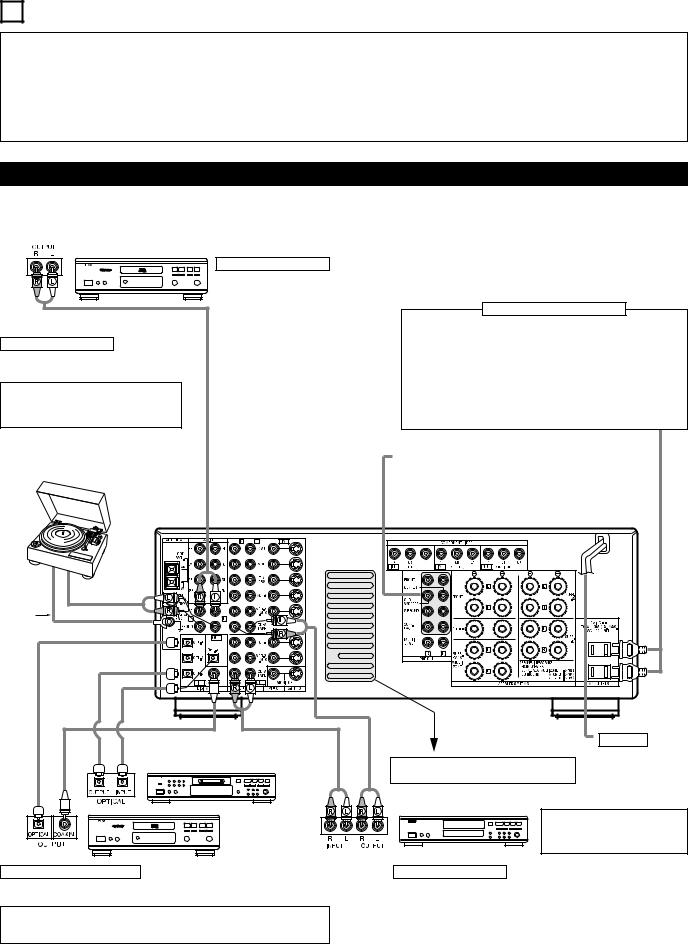
5 CONNECTIONS
•Do not plug in the AC cord until all connections have been completed.
•Be sure to connect the left and right channels properly (left with left, right with right).
•Insert the plugs securely. Incomplete connections will result in the generation of noise.
•Use the AC OUTLETS for audio equipment only. Do not use them for hair driers, etc.
•Note that binding pin plug cords together with AC cords or placing them near a power transformer will result in generating hum or other noise.
•Noise or humming may be generated if a connected audio equipment is used independently without turning the power of this unit on. If this happens, turn on the power of the this unit.
Connecting the audio components
•When making connections, also refer to the operating instructions of the other components.
The power to these outlets is turned on and off when the power is switched between on and standby from the remote control unit or power switch.
CD player
|
Connecting a CD player |
|
|
Connect the CD player’s analog output |
|
|
jacks (ANALOG OUTPUT) to this unit’s CD |
|
|
jacks using pin plug cords. |
|
|
Connecting the AC OUTLTETS |
|
|
AC OUTLETS |
|
Connecting a turntable |
• SWITCHED |
|
(total capacity – 120 W (1 A.)) |
||
Connect the turntable’s output cord to the AVR- |
The power to these outlets is turned on and off in conjunction with the |
|
POWER operation switch on the main unit, and when the power is switched |
||
3801’s PHONO jacks, the L (left) plug to the L jack, |
||
between on and standby from the remote control unit. |
||
the R (right) plug to the right jack. |
||
No power is supplied from these outlets when this unit’s power is at standby. |
||
NOTE: |
||
Never connect equipment whose total capacity is above 120 W (1 A.). |
||
This unit cannot be used with MC cartridges |
NOTE: |
|
directly. Use a separate head amplifier or step-up |
Only use the AC OUTLETS for audio equipment. Never use them for hair |
|
transformer. |
driers, TVs or other electrical appliances. |
|
If humming or other noise is generated when the |
|
|
ground wire is connected, disconnect the ground |
|
|
wire. |
Connecting the pre-out jacks |
|
|
Turntable
Use these jacks if you wish to connect external power amplifier(s) to
(MM cartridge) increase the power of the front, center and surround sound channels, or for connection to powered loudspeakers.

 To use Surround back with one speaker, connect the speaker to
To use Surround back with one speaker, connect the speaker to
SURR. BACK L CH.
Ground |
|
wire |
|
|
AC CORD |
MD recorder, CD recorder or other component |
AC 120 V, 60 Hz |
equipped with digital output jacks |
Route the connection cords, etc., in such a way |
|
that they do not obstruct the ventilation holes. |
|
|
CD recorder or Tape deck |
|
CD player or other |
NOTE: |
|
If humming noise is generated by a |
|
|
component equipped |
|
|
tape deck, etc., move the tape deck |
|
|
with digital output jacks |
|
|
away. |
|
|
|
|
Connecting the DIGITAL jacks |
|
Connecting a tape deck |
Use these for connections to audio equipment with digital output. Refer to page 25 for instructions on setting this terminal.
NOTES:
•Use 75 Ω /ohms cable pin cords for coaxial connections.
•Use optical cables for optical connections, removing the cap before connecting.
Connections for recording:
Connect the tape deck’s recording input jacks (LINE IN or REC) to this unit’s tape recording (CDR/TAPE OUT) jacks using pin plug cords.
Connections for playback:
Connect the tape deck’s playback output jacks (LINE OUT or PB) to this unit’s tape playback (CDR/TAPE IN) jacks using pin plug cords.
6
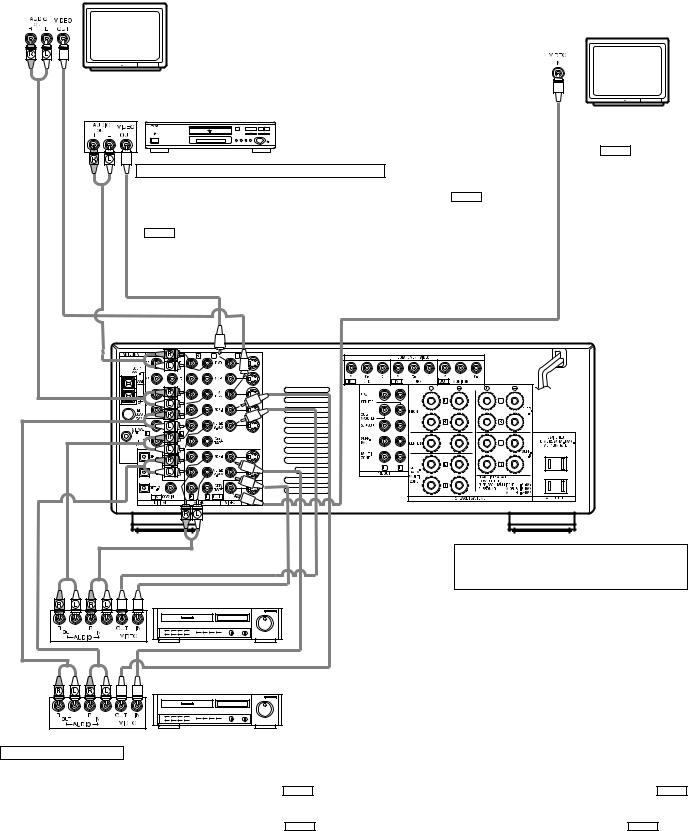
|
Connecting video components |
|
|
|
|
|
|
|
|
|
|
|
|||||||||||||||||||
• |
To connect the video signal, connect using a 75 Ω /ohms video signal cable cord. Using an improper cable can result in a drop in video quality. |
||||||||||||||||||||||||||||||
• |
When making connections, also refer to the operating instructions of the other components. |
|
|
|
|
|
|
|
|
|
|
|
|||||||||||||||||||
|
|
|
|
|
|
|
|
|
|
|
|
|
|
TV or DBS tuner |
|
|
|
|
|
|
|
|
|
|
|
|
|
|
|||
|
|
|
|
|
|
|
|
|
|
|
|
|
|
|
Connecting a TV/DBS tuner |
|
|
|
|
|
|
|
|
|
|
|
|
||||
|
|
|
|
|
|
|
|
|
|
|
|
|
|
|
|
|
|
|
|
|
|
|
|
|
|
|
|
|
|
|
|
|
|
|
|
|
|
|
|
|
|
|
|
|
|
|
|
|
|
TV/DBS |
|
|
|
|
|
|
|
|
|
|
|
||
|
|
|
|
|
|
|
|
|
|
|
|
|
|
|
|
|
|
• Connect the TV’s or DBS tuner’s video output jack (VIDEO OUTPUT) to the |
VIDEO |
|
|||||||||||
|
|
|
|
|
|
|
|
|
|
|
|
|
|
|
|
|
|
|
(yellow) TV/DBS IN jack using a 75 Ω /ohms video coaxial pin plug cord. |
|
|
|
|
|
|
Monitor TV |
|||||
|
|
|
|
|
|
|
|
|
|
|
|
|
|
|
|
|
|
|
|
|
|
|
|
|
|
|
|
|
|
||
|
|
|
|
|
|
|
|
|
|
|
|
|
|
|
|
|
|
• Connect the TV’s or DBS tuner’s audio output jacks (AUDIO OUTPUT) to the |
AUDIO |
|
|
|
|
|
|
|
|
|
|
||
|
|
|
|
|
|
|
|
|
|
|
|
|
|
|
|
|
|
|
TV/DBS IN jacks using pin plug cords. |
|
|
|
|
|
|
|
|
|
|
|
|
|
|
|
|
|
|
|
|
|
|
|
|
|
|
|
|
|
|
|
|
|
|
|
|
|
|
|
|
|
|||
|
|
|
|
|
|
|
|
|
|
|
|
|
|
|
|
|
|
|
|
|
|
|
|
|
|
|
|
|
|
|
|
|
|
|
|
|
|
|
|
|
|
|
|
|
|
|
|
|
|
|
|
|
|
|
|
|
|
|
|
|
|
|
|
|
|
|
|
|
|
|
|
|
|
|
|
|
|
|
|
|
|
|
|
|
|
|
|
|
|
|
|
|
|
|
|
|
|
|
|
|
|
|
|
|
|
|
|
|
|
|
|
|
|
|
|
|
|
|
|
|
|
|
|
|
|
|
|
|
|
|
|
|
|
|
|
|
|
|
|
|
|
|
|
|
|
|
|
|
|
|
|
|
|
|
|
|
|
|
|
|
|
|
|
|
|
|
|
|
|
|
|
|
|
|
|
|
|
|
|
|
|
|
|
|
|
|
|
|
|
|
|
|
MONITOR OUT |
|
|
|
|
DVD player or video disc player (VDP), etc. |
• Connect the |
TV’s |
video |
||
input jack (VIDEO INPUT) to |
|||||
|
the |
VIDEO |
MONITOR |
||
Connecting a DVD player or a video disc player (VDP) |
OUT |
jack using |
a |
75 |
|
Ω /ohms video |
coaxial |
pin |
|||
DVD |
plug cord. |
|
|
|
|
• Connect the video disc player’s video output jack (VIDEO OUTPUT) to the |
VIDEO (yellow) DVD IN |
|
|
|
|
jack using a 75 Ω /ohms video coaxial pin plug cord. |
|
|
|
|
|
•Connect the video disc player’s analog audio output jacks (ANALOG AUDIO OUTPUT) to the AUDIO DVD IN jacks using pin plug cords.
•A VDP can be connected to the VDP jacks in the same way.
•It is also possible to connect a video disc player, DVD player, video camcorder, game machine, etc., to the VCR-2/V.AUX jacks.
Video deck 2 |
Video deck 1
Note on connecting the digital input jacks
•Only audio signals are input to the digital input jacks. For details, see page 6.
Connecting a video decks
•There are two sets of video deck (VCR) jacks, so two video decks can be connected for simultaneous recording or video copying.
Video input/output connections:
•Connect the video deck’s video output jack (VIDEO OUT) to the VIDEO (yellow) VCR-1 IN jack, and the video deck’s video input jack (VIDEO IN) to the VIDEO
(yellow) VCR-1 OUT jack using 75 Ω /ohms video coaxial pin plug cords.
Connecting the audio output jacks
•Connect the video deck’s audio output jacks (AUDIO OUT) to the AUDIO VCR-1 IN jacks, and the video deck’s audio input jacks (AUDIO IN) to the AUDIO VCR-1 OUT jacks using pin plug cords.

 Connect the second video deck to the VCR-2/V.AUX jacks in the same way.
Connect the second video deck to the VCR-2/V.AUX jacks in the same way.
7
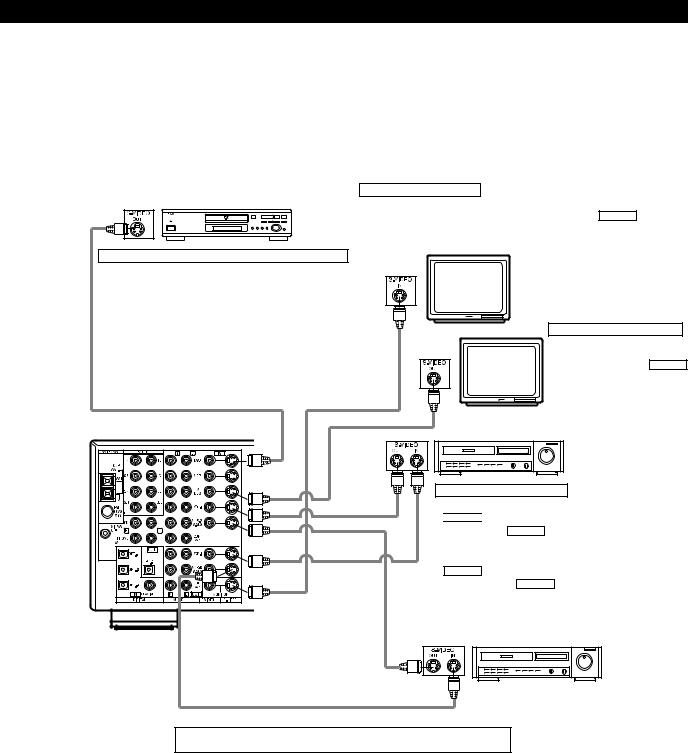
Connecting a video component equipped with S-Video jacks
•When making connections, also refer to the operating instructions of the other components.
•A note on the S input jacks
The input selectors for the S inputs and pin jack inputs work in conjunction with each other.
•Precaution when using S-jacks
This unit’s S-jacks (input and output) and video pin jacks (input and output) have independent circuit structures, so that video signals input from the S-jacks are only output from the S-jack outputs and video signals input from the pin jacks are only output from the pin jack outputs. When connecting this unit with equipment that is equipped with S-jacks, keep the above point in mind and make connections according to the equipment’s instruction manuals.
Connecting a monitor TV
DVD player or video disc player (VDP)
MONITOR OUT
• Connect the TV’s S video input (S-VIDEO INPUT) to the S-VIDEO MONITOR OUT jack using a S jack connection cord.
Connecting a DVD player or a video disc player (VDP)
DVD
•Connect the DVD player’s S-Video output jack to the S-VIDEO DVD IN jack using an S-Video connection cord.
•A VDP can be connected to the VDP jacks in the same way.
•It is also possible to connect a video disc player, DVD player, video camcorder, game machine, etc., to the VCR-2/V.AUX jacks.
Monitor TV
Connecting a TV/DBS tuner
• Connect the TV’s or DBS tuner’s S video output jack (S-VIDEO OUTPUT) to the S-VIDEO TV/DBS IN jack using an S jack connection cord.
TV or satellite broadcast tuner
Video deck 1
Connecting the video decks
• Connect the video deck’s S output jack (S-OUT) to the 


 S-VIDEO
S-VIDEO
 VCR-1 IN jack and the video deck’s S input jack
VCR-1 IN jack and the video deck’s S input jack
(S-IN) to the S-VIDEO VCR-1 OUT jack using S jack  connection cords.
connection cords. 




• Connect the video deck’s S output jack (S-OUT) to the S-VIDEO VCR-2/V.AUX IN jack and the video deck’s S input 

 jack
jack (S-IN)
(S-IN) to
to the S-VIDEO VCR-2/V.AUX OUT jack using S
the S-VIDEO VCR-2/V.AUX OUT jack using S

 jack connection cords.
jack connection cords.

Video deck 2
Connect the components’ audio inputs and outputs as described on page 6.
8
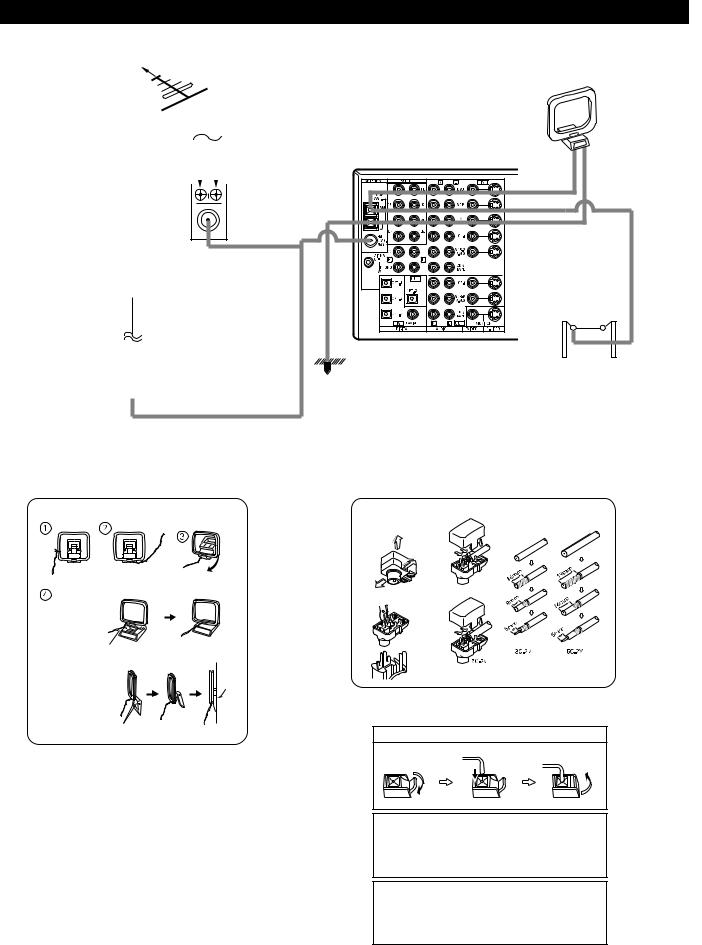
Connecting the antenna terminals
DIRECTION OF
BROADCASTING
STATION AM LOOP ANTENNA
(Supplied)
|
|
|
FM ANTENNA |
|||
75 Ω /ohms |
|
|
|
|
|
300 Ω /ohms |
COAXIAL |
|
|
|
|
|
FEEDER |
CABLE |
|
|
|
|
|
CABLE |
|
|
|
|
|
|
|
|
|
|
|
|
|
|
|
|
|
|
|
|
|
|
|
|
|
|
|
|
FM ANTENNA ADAPTER (Supplied)
AM OUTDOOR
ANTENNA
FM INDOOR |
|
|
|
|
|
|
|
|
|
|
|
|
|
|
|
|
|
|
|
|
|
300 Ω /ohms |
GROUND |
|||
|
|
|
|
|||||
ANTENNA |
|
|
|
|
||||
(Supplied) |
|
|
|
|
|
|
|
|
•An F-type FM antenna cable plug can be connected directly.
•If the FM antenna cable’s plug is not of the F-type, connect using the included antenna adapter.
AM loop antenna assembly
Remove the vinyl tie and take out the connection line.
a.With the antenna on top any stable
surface.
Mount
b. With the antenna attached to a wall.
Connect to the AM antenna terminals.
Bend in the reverse direction.
Installation hole Mount on wall, etc.
FM antenna adopter assembly
75 Ω /ohms COAXIAL CABLE
Open the cover
SHUT
PULL
CLAMP
CLAMP
PULL
ANTENNA ADAPTER
SHUT
REMOVE
CLAMP
CLAMP
Connection of AM antennas
1. Push the lever. 2. Insert the conductor. 3. Return the lever.
Note to CATV system installer:
This reminder is provided to call the CATV system installer’s attention to Article 820-40 of the NEC which provides guidelines for proper grounding and, in particular, specifies that the cable ground shall be connected to the grounding system of the building, as close to the point of cable entry as practical.
Notes:
•Do not connect two FM antennas simultaneously.
•Even if an external AM antenna is used, do not disconnect the AM loop antenna.
•Make sure AM loop antenna lead terminals do not touch metal parts of the panel.
9
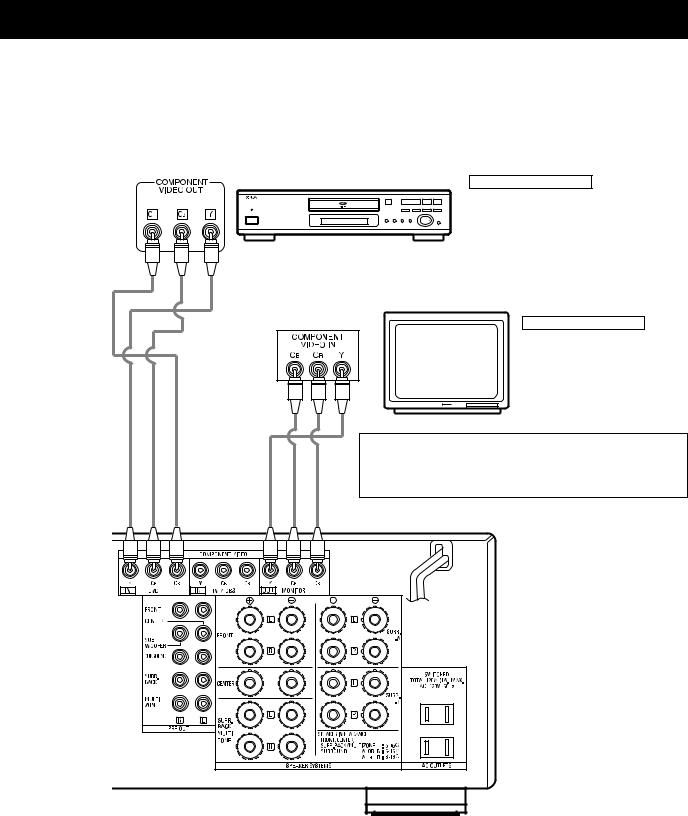
Connecting a Video Component Equipped with Color Difference (Component - Y, CR, CB) Video Jacks (DVD Player)
•When making connections, also refer to the operating instructions of the other components.
•The signals input to the color difference (component) video jacks are not output from the VIDEO output jack (yellow) or the S-Video output jack. In addition, the video signals input to the VIDEO input (yellow) and S-Video input jacks are not output to the color difference (component) video jacks.
•The AVR-3801’s on-screen display signals are not output from the color difference (component) video output jacks (MONITOR OUT).
•Some video sources with component video outputs are labeled Y, CB, CR, or Y, Pb, Pr, or Y, R-Y, B-Y. These terms all refer to component video color difference output.
DVD player
Connecting a DVD player
DVD IN jacks
• Connect the DVD player’s color difference (component) video output jacks (COMPONENT VIDEO OUTPUT) to the COMPONENT DVD IN jack using 75 Ω /ohms coaxial video pin-plug cords.
•In the same way, another video source with component video outputs such as a TV/DBS tuner, etc., can be connected to the TV/DBS color difference (component) video jacks.
Monitor TV
Connecting a monitor TV
MONITOR OUT jack
• Connect the TV’s color difference (component) video input jacks (COMPONENT VIDEO INPUT) to the COMPONENT MONITOR OUT jack using 75 Ω /ohms coaxial video pinplug cords.
•The color difference input jacks may be indicated differently on some TVs, monitors or video components (“CR, CB and Y”, “R-Y, B-Y and Y”, “Pr, Pb and Y”, etc.). For details, carefully read the operating instructions included with the TV or other component.
10
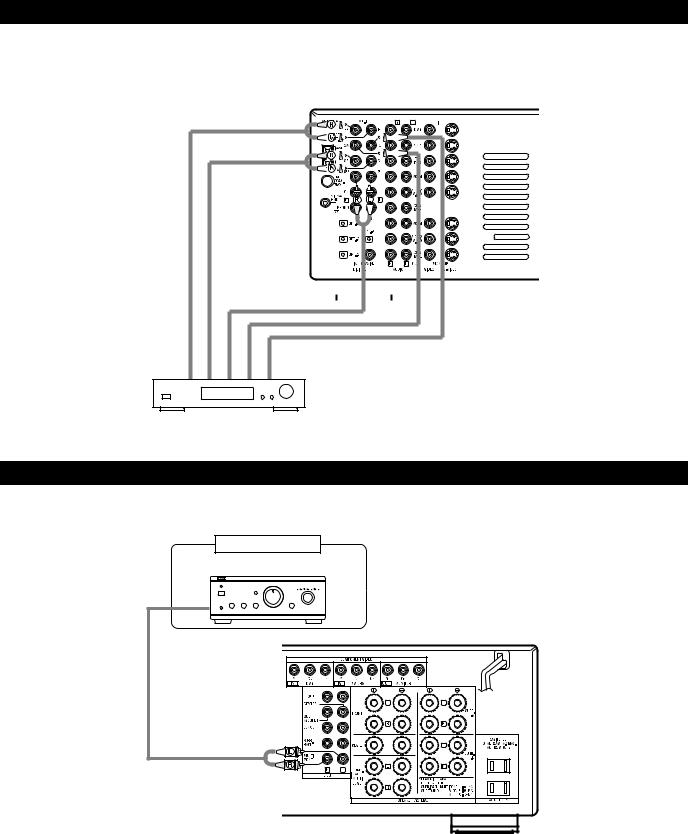
Connecting the external input (EXT. IN) jacks
•These jacks are for inputting multi-channel audio signals from an outboard decoder, or a component with a different type of multi-channel decoder, such as a Super Audio DVD player, or a multi-channel SACD player, or other future multi-channel sound format decoder.
•When making connections, also refer to the operating instructions of the other components.
|
Surround |
Surround back |
Subwoofer |
|
|
|
|
|
|
|
|
|
|
|
|
|
|
|
|
|
|
|
|
|
|
|
|
|
|
|
|
|
|
|
|
|
|
|
|
|
|
|
|
|
|
|
|||
|
|
|
|
|
|
|
|
|
|
|
|
|
|
|
|
|
|
|
|
|
|
|||
|
|
|
|
|
|
|
|
|
|
|
|
|
|
|
|
|
|
|
|
|
|
|||
|
|
|
|
|
|
|
|
|
|
|
|
|
|
|
|
|
|
|
|
|
|
|||
|
|
|
|
|
|
|
|
|
|
|
|
|
|
|
|
|
|
|
|
|
|
|||
|
|
|
|
|
|
|
|
|
|
|
|
|
|
|
|
|
|
|
|
|
|
|||
|
|
|
|
|
|
|
|
|
|
|
|
|
|
|
|
|
|
|
|
|
|
|||
|
|
|
|
|
|
|
|
|
|
|
|
|
|
|
|
|
|
|
|
|
|
|||
|
|
|
|
|
|
|
|
|
|
|
|
|
|
|
|
|
|
|
|
|
|
|||
|
|
|
|
|
|
|
|
|
|
|
|
|
|
|
|
|
|
|
|
|
|
|||
|
|
|
|
|
|
|
|
|
|
|
|
|
|
|
|
|
|
|
|
|
|
|||
|
|
|
|
|
|
|
|
|
|
|
|
|
|
|
|
|
|
|
|
|
|
|||
|
|
|
|
|
|
|
|
|
|
|
|
|
|
|
|
|
|
|
|
|
|
|||
|
|
|
|
|
|
|
|
|
|
|
|
|
|
|
|
|
|
|
|
|
|
|||
Front |
Center |
|
|
|
|
|
|
|
|
|
|
|
|
|
|
|
||||||||
Decoder with 8- or 6-channel analog output

 For instructions on playback using the external input (EXT. IN) jacks, see page 47.
For instructions on playback using the external input (EXT. IN) jacks, see page 47.
Connecting the MULTI ZONE jacks
•If another pre-main (integrated) amplifier or power amplifier is connected, the multi-source jacks can be used to play a different program source in another room at the same time.
Another room
Integrated pre-main amplifier or power amplifier

 For instructions on operations using the MULTI ZONE jacks, see page 45, 46 or page 48.
For instructions on operations using the MULTI ZONE jacks, see page 45, 46 or page 48.
11
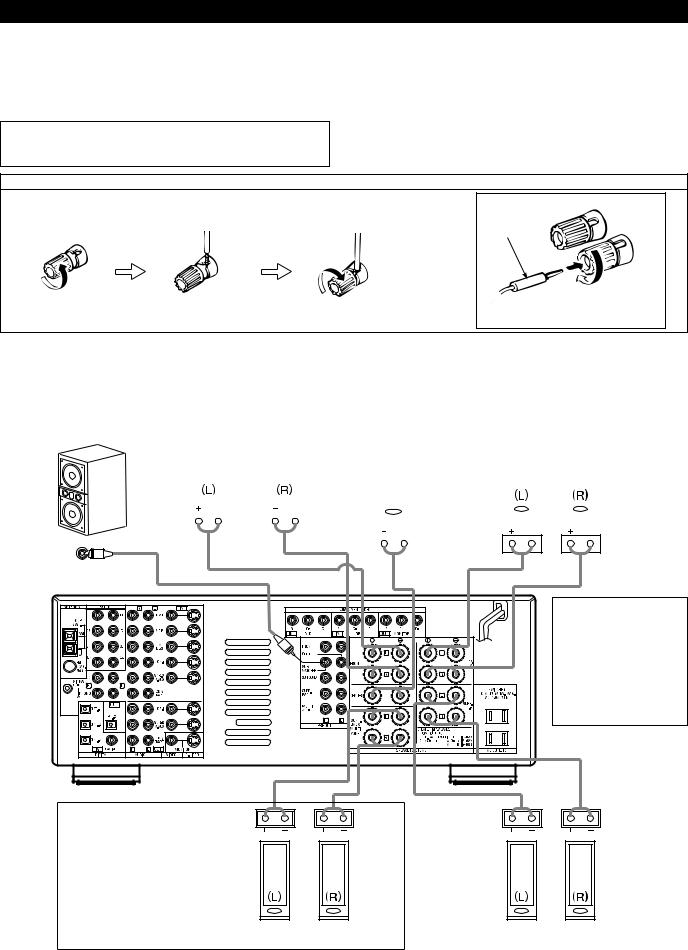
Speaker system connections
•Connect the speaker terminals with the speakers making sure that like polarities are matched (Å with Å , à with à ). Mismatching of polarities will result in weak central sound, unclear orientation of the various instruments, and the sense of direction of the stereo being impaired.
•When making connections, take care that none of the individual conductors of the speaker cord come in contact with adjacent terminals, with other speaker cord conductors, or with the rear panel.
NOTE:
NEVER touch the speaker terminals when the power is on. Doing so could result in electric shocks.
Speaker Impedance
•Speakers with an impedance of from 6 to 16 Ω /ohms can be connected for use as front and center speakers.
•Speakers with an impedance of 6 to 16 Ω /ohms can be connected for use as surround speakers.
•Be careful when using two pairs of surround speakers (A + B) at the same time, since use of speakers with an impedance of less than 8 Ω /ohms will
lead to damage.
•The protector circuit may be activated if the set is played for long periods of time at high volumes when speakers with an impedance lower than the specified impedance are connected.
Connection the speaker terminals
1. Loosen by turning |
2. Insert the cord. |
3. Tighten by turning |
Connecting banana plugs |
counterclockwise |
|
clockwise. |
|
|
|
|
banana plug |
Turn clockwise to tighten, then insert the banana plug.
Connections
• When making connections, also refer to the operating instructions of the other components.
Connection jack for subwoofer |
|
|
FRONT SPEAKER |
|
|
|
|
CENTER SPEAKER SYSTEM |
|
SURROUND SPEAKER SYSTEMS (A) |
|||||||||||||||||||||||||||||||
with built-in |
|
amplifier (super |
|
|
|
|
|
||||||||||||||||||||||||||||||||||
|
|
|
|
|
|
SYSTEMS |
|
|
|
|
|
|
|
|
|
|
|
|
|
|
|
|
|
|
|
|
|
|
|
|
|||||||||||
woofer), etc. |
|
|
|
|
|
|
|
|
|
|
|
|
|
|
|
|
|
|
|
|
|
|
|
|
|
|
|
|
|
|
|
|
|||||||||
|
|
|
|
|
|
|
|
|
|
|
|
|
|
|
|
|
|
|
|
|
|
|
|
|
|
|
|
|
|
|
|
|
|
|
|
|
|
|
|||
|
|
|
|
|
|
|
|
|
|
|
|
|
|
|
|
|
|
|
|
|
|
|
|
|
|
|
|
|
|
|
|
|
|
|
|
|
|
|
|||
|
|
|
|
|
|
|
|
|
|
|
|
|
|
|
|
|
|
|
|
|
|
|
|
|
|
|
|
|
|
|
|
|
|
|
|
|
|
|
|
|
|
|
|
|
|
|
|
|
|
|
|
|
|
|
|
|
|
|
|
|
|
|
|
|
|
|
|
|
|
|
|
|
|
|
|
|
|
|
|
|
|
|
|
|
|
|
|
|
|
|
|
|
|
|
|
|
|
|
|
|
|
|
|
|
|
|
|
|
|
|
|
|
|
|
|
|
|
|
|
|
|
|
|
|
|
|
|
|
|
|
|
|
|
|
|
|
|
|
|
|
|
|
|
|
|
|
|
|
|
|
|
|
|
|
|
|
|
|
|
|
|
|
|
|
|
|
|
|
|
|
|
|
|
|
|
|
|
|
|
|
|
|
|
|
|
|
|
|
|
|
|
|
|
|
|
|
|
|
|
|
|
|
|
|
|
|
|
|
|
|
|
|
|
|
|
|
|
|
|
|
|
|
|
|
|
|
|
|
|
|
|
|
|
|
|
|
|
|
|
|
|
|
|
|
|
|
|
|
|
|
|
|
|
|
|
|
|
|
|
|
|
|
|
|
|
|
|
|
|
|
|
|
|
|
|
|
|
|
|
|
|
|
|
|
|
|
|
|
|
|
|
|
|
|
|
|
|
|
|
|
|
|
|
|
|
|
|
|
|
|
|
|
|
|
|
|
|
|
|
|
|
|
|
|
|
|
|
|
|
|
|
|
|
|
|
|
|
|
|
|
|
|
|
|
|
|
|
|
|
|
|
|
|
|
|
|
|
|
|
|
|
|
|
|
|
|
|
|
|
|
|
|
|
|
|
|
|
|
|
|
|
|
|
|
|
|
|
|
|
|
|
|
|
|
|
|
|
|
|
|
|
|
|
|
|
|
|
|
|
|
|
|
|
|
|
|
|
|
|
|
|
|
|
|
|
|
|
|
|
|
|
|
|
|
|
|
|
|
|
|
|
|
|
|
|
|
|
|
|
|
|
|
|
|
|
|
|
|
|
|
|
• Precautions when connecting speakers
If a speaker is placed near a TV or video monitor, the colors on the screen may be disturbed by the speaker’s magnetism. If this should happen, move the speaker away to a position where it does not have this effect.
NOTES:
•To use Surround back with one speaker, connect the speaker to SURR. BACK L CH.
•The settings must be changed to use this speaker for MULTI ZONE.
See page 18.
SURROUND BACK/MULTI ZONE SPEAKER SYSTEMS |
|
SURROUND SPEAKER SYSTEMS (B) |
12
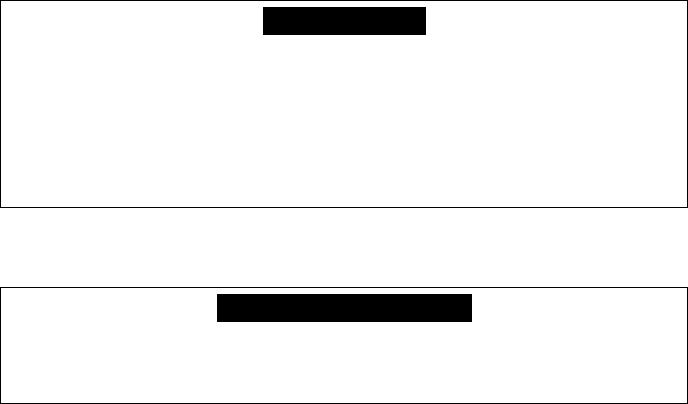
Protector circuit
•This unit is equipped with a high-speed protection circuit. The purpose of this circuit is to protect the speakers under circumstances such as when the output of the power amplifier is inadvertently short-circuited and a large current flows, when the temperature surrounding the unit becomes unusually high, or when the unit is used at high output over a long period which results in an extreme temperature rise.
When the protection circuit is activated, the speaker output is cut off and the power supply indicator LED flashes. Should this occur, please follow these steps: be sure to switch off the power of this unit, check whether there are any faults with the wiring of the speaker cables or input cables, and wait for the unit to cool down if it is very hot. Improve the ventilation condition around the unit and switch the power back on.
If the protection circuit is activated again even though there are no problems with the wiring or the ventilation around the unit, switch off the power and contact a DENON service center.
Note on speaker impedance
•The protector circuit may be activated if the set is played for long periods of time at high volumes when speakers with an impedance lower than the specified impedance (for example speakers with an impedance of lower than 4 Ω /ohms) are
connected. If the protector circuit is activated, the speaker output is cut off. Turn off the set’s power, wait for the set to cool down, improve the ventilation around the set, then turn the power back on.
13
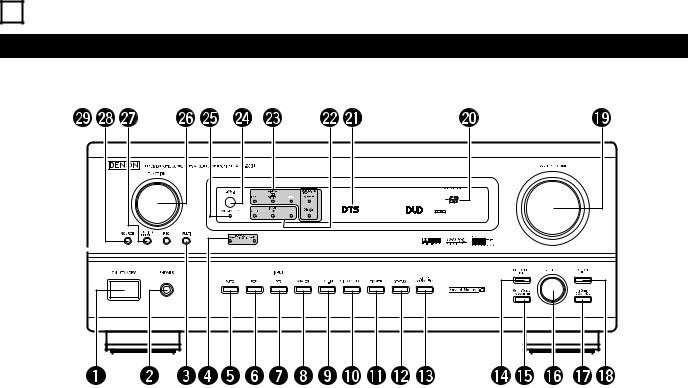
6 PART NAMES AND FUNCTIONS
Front Panel
• For details on the functions of these parts, refer to the pages given in parentheses ( ).
|
|
|
|
|
|
|
|
|
|
|
|
|
|
|
|
|
|
|
|
|
|
|
|
|
|
|
|
|
|
|
|
|
|
|
|
|
|
|
|
|
|
|
|
|
|
|
|
|
|
|
|
|
|
|
|
|
|
|
|
|
|
|
|
|
|
....................................................q Power ON/STANDBY switch |
(41) |
|||||||||
w Headphones jack (PHONES) .................................................... |
(44) |
|||||||||
e MULTI button ........................................................................... |
(46) |
|||||||||
rSurround speaker system indicators (SURROUND SPEAKER A/B)
t AUTO button ............................................................................ |
(42) |
y PCM button .............................................................................. |
(43) |
u DTS button ............................................................................... |
(43) |
i ANALOG button ....................................................................... |
(42) |
o EXT. IN button .......................................................................... |
(42) |
!0VIDEO SELECT button ............................................................. |
(45) |
!1DIMMER button ....................................................................... |
(45) |
!2STATUS button ......................................................................... |
(45) |
!36.1/7.1 SURROUND button...................................................... |
(51) |
!4SURROUND MODE button...................................................... |
(43) |
!5SURROUND PARAMETER button ........................................... |
(52) |
!6SELECT knob............................................................................ |
(43) |
!7TONE CONTROL button .......................................................... |
(44) |
!8CH. VOL button........................................................................ |
(49) |
!9MASTER VOLUME control ...................................................... |
(43) |
@0Master volume indicator (VOLUME LEVEL) ............................ |
(43) |
@1Display |
|
@2INPUT indicators....................................................................... |
(43) |
@3SIGNAL indicators .................................................................... |
(43) |
@4Remote control sensor (REMOTE SENSOR) ........................... |
(29) |
@5Power indicator ........................................................................ |
(41) |
@6FUNCTION knob....................................................................... |
(42) |
@7TUNING PRESET button .......................................................... |
(60) |
@8SOURCE selector button ......................................................... |
(42) |
@9REC selector button ................................................................. |
(45) |
14
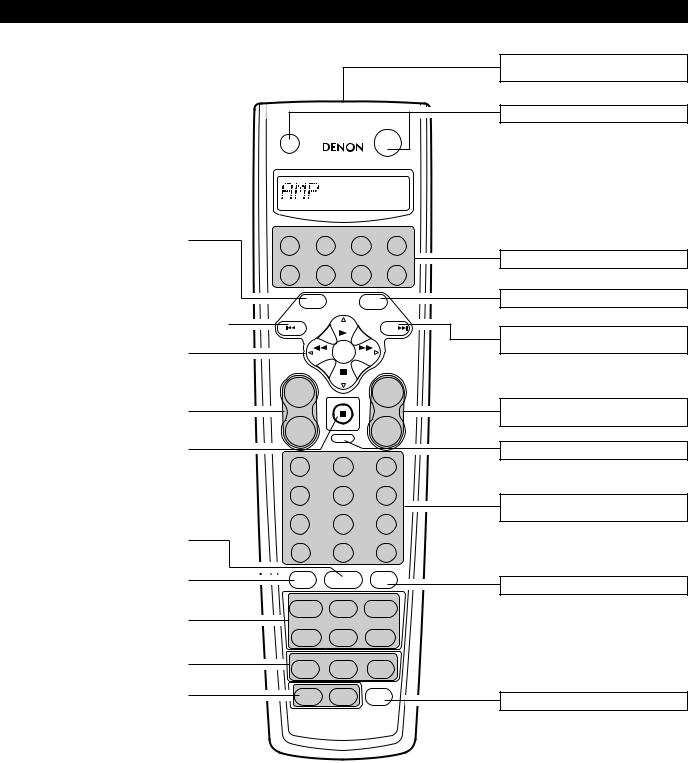
Remote control unit
• For details on the functions of these parts, refer to the pages given in parentheses ( ).
DISPLAY/SURR. PARA |
|
|
button ..................................................... |
(52) |
|
|
|
|
|
|
|
System setup/ |
|
|
......................................system buttons |
(16) |
|
|
|
|
|
|
|
|
|
|
Tuner system/ |
|
|
system button ........................................ |
(16) |
|
|
|
|
|
|
|
System buttons ...................................... |
(59) |
|
|
|
|
|
|
|
ENTER/system button............................ |
(16) |
|
|
|
|
.........................Speaker selector button |
(54) |
|
|
|
|
TEST TONE button................................. |
(49) |
|
|
|
|
Surround mode buttons ......................... |
(54) |
|
|
|
|
Input mode selector buttons.................. |
(42) |
|
|
|
|
SYSTEM CALL buttons .......................... |
(35) |
|
|
|
Remote control signal |
|
|
transmitter.............................................. |
(29) |
|
Power button.......................................... |
(41) |
|
POWER |
|
OFF |
ON / |
|
SOURCE |
|
|
|
RC-883 |
|
|
REMOTE CONTROL UNIT |
|
TV |
CD |
CDR/MD/TAPE RECEIVER |
VCR DBS/CABLE
DISPLAY
SURR.
PARA.
SETUP
TUNING
BAND
VDP |
DVD |
Mode selector buttons........................... |
(32) |
MENU |
|
MENU/OSD button |
(45) |
OSD |
|
||
|
|
|
|
RETURN |
|
|
|
|
A/B |
RETURN/MEMORY/system |
|
|
|
(59) |
|
|
MEMORY |
buttons ................................................... |
|
|
|
|
|
MODE |
|
|
|
CHANNEL |
VOLUME |
TUNING
++
SKIP |
ENTER |
|
Master volume control |
|
|
|
|
|
|
||
- |
|
- |
buttons ................................................... |
(43) |
|
SHIFT |
|
|
|||
SKIP |
MUTING |
|
|
||
TUNER |
PHONO |
CD |
MUTING button...................................... |
(44) |
|
1 |
2 |
3 |
|
|
|
CDR/TAPE |
VDP |
DVD |
|
|
|
4 |
5 |
6 |
Input source selector |
|
|
|
|
|
|
||
VCR-1 |
VCR-2/V.AUX |
TV/DBS |
buttons |
(42) |
|
7 |
8 |
9 |
|||
|
|
||||
TV/ |
0 |
+10 |
|
|
|
VCR |
|
|
|||
TEST |
SPEAKER |
OUTPUT |
OUTPUT button |
(44) |
|
TONE |
|||||
|
|
||||
|
|
|
|||
|
SURROUND |
|
|
|
|
DOLBY/DTS |
DSP |
5CH / 7CH |
|
|
|
SURROUND |
SIMU. |
STEREO |
|
|
|
6.1 / 7.1 |
DIRECT |
STEREO |
|
|
|
SURROUND |
|
|
|||
|
|
|
|
||
|
INPUT |
|
|
|
|
MODE |
ANALOG |
EXT.IN |
|
|
|
SYSTEM CALL |
|
|
|
||
CALL 1 |
CALL 2 |
BACKLIGHT |
BACKLIGHT button |
|
|
|
|
|
|
||
15

7SETTING UP THE SYSTEM
•Once all connections with other AV components have been completed as described in “CONNECTIONS” (see pages 6 to 13), make the various settings described below on the monitor screen using the AVR-3801’s on-screen display function.
These settings are required to set up the listening room’s AV system centered around the AVR-3801.
•Use the following buttons to set up the system:
DISPLAY |
|
MENU |
SURR. |
|
OSD |
PARA. |
|
|
|
|
|
SETUP |
|
RETURN |
|
TUNING |
A/B |
|
|
|
|
|
MEMORY |
BAND |
|
MODE |
CHANNEL |
|
VOLUME |
TUNING
++
SKIP ENTER
- |
SHIFT |
- |
SKIP |
MUTING |
|
TUNER |
PHONO |
CD |
SYSTEM SETUP button
Press this to display the system setup menu.
CURSOR buttons
F and G: Use these to move the cursors (F and G) to the left and right on the screen.
D and H: Use these to move the cursors (D and H) to the up and down on the screen.
ENTER button
Press this to switch the display.
Also use this button to complete the setting.
• System setup items and default values (set upon shipment from the factory)
|
|
|
System setup |
|
|
|
|
|
|
|
|
|
|
|
|
|
Default settings |
|
|
|
|
|
|
|
|
|
|
|||||
q |
Power AMP |
Set this to switch the surround back channel’s power amplifier for |
|
|
|
|
|
|
|
|
|
|
|
|
Surround Back |
|
|
|
|
|
|
|
|
|
|
|||||||
Assignment |
use for multi-zone. |
|
|
|
|
|
|
|
|
|
|
|
|
|
|
|
|
|
|
|
|
|
|
|
||||||||
|
|
|
|
|
|
|
|
|
|
|
|
|
|
|
|
|
|
|
|
|
|
|
|
|
|
|
|
|
|
|||
|
|
|
|
|
|
|
|
|
|
|
|
|
|
|
|
|
|
|
|
|
|
|
|
|
|
|
|
|
|
|||
|
|
Input the combination of speakers in your system and their |
Front Sp. |
|
|
|
Center Sp. |
|
|
Surround Sp. |
|
|
|
Surround Back Sp. |
|
Sub Woofer |
||||||||||||||||
|
Speaker |
corresponding sizes (SMALL for regular speakers, LARGE for full- |
|
|
|
|
|
|
A / B |
|
|
|
|
|||||||||||||||||||
|
|
|
|
|
|
|
|
|
|
|
|
|
|
|
|
|
|
|
|
|
|
|
|
|
|
|||||||
|
Configuration |
size, full-range) to automatically set the composition of the signals |
Large |
|
|
|
|
Small |
|
|
|
|
Small |
|
|
|
Small / 2spkrs |
|
|
Yes |
||||||||||||
|
|
output from the speakers and the frequency response. |
|
|
|
|
|
|
|
|
|
|
|
|
|
|
||||||||||||||||
|
|
Use this function when using multiple surround speaker |
Surround |
DOLBY/ |
|
|
|
|
|
|
|
|
|
|
|
|
|
|
|
|
|
|
|
|
|
|
|
|
|
|||
|
|
|
|
|
|
5CH/7CH |
|
|
|
DSP |
|
|
|
|
— |
|
|
— |
||||||||||||||
|
|
DTS |
|
|
|
|
|
|
|
|
EXT. IN |
|
|
|
||||||||||||||||||
w |
(Surround |
combinations for more ideal surround sound. Once the |
mode |
|
|
|
|
STEREO |
|
|
|
SIMULATION |
|
|
|
|
||||||||||||||||
SURROUND |
|
|
|
|
|
|
|
|
|
|
|
|
|
|
|
|
|
|||||||||||||||
|
combinations of surround speakers to be used for the |
|
|
|
|
|
|
|
|
|
|
|
|
|
|
|
|
|
|
|
|
|
|
|
|
|
|
|||||
|
Speaker |
|
|
|
|
|
|
|
|
|
|
|
|
|
|
|
|
|
|
|
|
|
|
|
|
|
|
|
|
|
||
|
different |
surround modes are preset, the surround |
|
|
|
|
|
|
|
|
|
|
|
|
|
|
|
|
|
|
|
|
|
|
|
|
|
|
|
|
|
|
|
Setting) |
Surround |
|
|
|
|
|
|
|
|
|
|
|
|
|
|
|
|
|
|
|
|
|
|
|
|
|
|
|
|
||
|
speakers |
are selected automatically according to the |
A |
|
|
|
|
A |
|
|
|
|
A |
|
|
|
|
|
A |
|
— |
|
|
— |
||||||||
|
|
|
|
|
|
|
|
|
|
|
|
|
|
|
|
|
|
|||||||||||||||
|
|
surround mode. |
speaker |
|
|
|
|
|
|
|
|
|
|
|
|
|
|
|
|
|||||||||||||
|
|
|
|
|
|
|
|
|
|
|
|
|
|
|
|
|
|
|
|
|
|
|
|
|
|
|
|
|
|
|||
|
(Subwoofer mode) |
This selects the subwoofer speaker for playing deep bass signals. |
|
|
|
|
|
|
|
|
|
|
|
|
|
LFE |
|
|
|
|
|
|
|
|
|
|
||||||
e |
DTS-ES/6.1 |
Set the method of playing the surround back channel for digital |
|
|
|
|
|
|
|
DTS-ES / 6.1 Source Auto = OFF |
|
|
|
|
|
|
|
|||||||||||||||
Source Auto |
signals. |
|
|
|
|
|
|
|
|
|
|
|
|
|
|
|
|
|||||||||||||||
|
|
|
|
|
|
|
|
|
|
|
|
|
|
|
|
|
|
|
|
|
|
|
|
|
|
|
|
|
|
|
||
r Delay Time |
This parameter is for optimizing the timing with which the audio |
Front L & R |
|
Center |
|
|
|
Surround L & R |
|
SBL & SBR |
Sub Woofer |
|||||||||||||||||||||
|
|
|
|
|
||||||||||||||||||||||||||||
signals are produced from the speakers and subwoofer according to |
12 ft (3.6 m) |
|
12 ft (3.6 m) |
|
|
10 ft (3.0 m) |
|
10 ft (3.0 m) |
12 ft (3.6 m) |
|||||||||||||||||||||||
|
|
the listening position. |
|
|
|
|
|
|||||||||||||||||||||||||
|
Channel |
This adjusts the volume of the signals output from the speakers and |
Front L |
|
Front R |
|
Center |
|
|
Surround |
|
Surround |
|
|
Surround |
|
Surround |
Subwoofer |
||||||||||||||
|
|
|
|
|
|
|
|
|
||||||||||||||||||||||||
t |
|
|
|
|
|
L |
|
R |
|
|
Back L |
|
Back R |
|||||||||||||||||||
subwoofer for the different channels in order to obtain optimum |
|
|
|
|
|
|
|
|
|
|
|
|
|
|
|
|
|
|
|
|||||||||||||
Level |
|
|
|
|
|
|
|
|
|
|
|
|
|
|
|
|
|
|
|
|
|
|
|
|
|
|
|
|
||||
|
effects. |
|
|
0 dB |
|
0 dB |
|
0 dB |
|
|
|
0 dB |
|
0 dB |
|
|
0 dB |
|
0 dB |
|
0 dB |
|||||||||||
|
|
|
|
|
|
|
|
|
|
|
|
|
|
|||||||||||||||||||
|
|
|
|
Input |
|
|
|
|
|
|
|
|
|
|
|
|
|
|
|
|
|
|
|
|
|
|
|
|
|
|
|
|
|
|
|
|
CD |
|
|
DVD |
|
|
VDP |
|
|
TAPE |
|
TV/DBS |
|
|
|
VCR-1 |
|
|
VCR-2 |
|
|
— |
|
— |
|||||
|
Digital In |
This assigns the digital input jacks for the different input |
source |
|
|
|
|
|
|
|
|
|
|
|
|
|||||||||||||||||
y |
|
|
|
|
|
|
|
|
|
|
|
|
|
|
|
|
|
|
|
|
|
|
|
|
|
|
|
|
||||
Assignment |
sources. |
|
Digital |
|
|
|
|
|
|
|
|
|
|
|
|
|
|
|
|
|
|
|
|
|
|
|
|
|
|
|
|
|
|
|
COAXIAL |
OPTICAL 1 |
|
|
OPTICAL 2 |
|
OPTICAL 3 |
|
|
OFF |
|
|
|
OFF |
|
|
OFF |
|
|
— |
|
— |
|||||||||
|
|
|
|
Inputs |
|
|
|
|
|
|
|
|
|
|
|
|||||||||||||||||
|
|
|
|
|
|
|
|
|
|
|
|
|
|
|
|
|
|
|
|
|
|
|
|
|
|
|
|
|
|
|
|
|
u |
Multi |
This sets the output level for the mult output jacks. |
|
|
|
|
|
|
|
|
|
|
|
|
|
|
0 dB |
|
|
|
|
|
|
|
|
|
|
|||||
vol. Level |
|
|
|
|
|
|
|
|
|
|
|
|
|
|
|
|
|
|
|
|
|
|
|
|
||||||||
|
|
|
|
|
|
|
|
|
|
|
|
|
|
|
|
|
|
|
|
|
|
|
|
|
|
|
|
|
|
|
|
|
i |
On Screen |
This sets |
whether or not to display the on-screen display that |
|
|
|
|
|
|
|
|
|
On Screen Display = ON |
|
|
|
|
|
|
|
||||||||||||
appears on the monitor screen when the controls on the remote |
|
|
|
|
|
|
|
|
|
|
|
|
|
|
|
|
||||||||||||||||
Display |
|
|
|
|
|
|
|
|
|
|
|
|
|
|
|
|
||||||||||||||||
|
control unit or main unit are operated. |
|
|
|
|
|
|
|
|
|
|
|
|
|
|
|
|
|
|
|
|
|
|
|
|
|
|
|
|
|
||
|
|
|
|
|
|
|
|
|
|
|
|
|
|
|
|
|
|
|
|
|
|
|
|
|
|
|
|
|
|
|
||
|
|
|
|
|
|
|
|
|
|
|
|
|
|
|
||||||||||||||||||
|
|
|
|
|
A1 ~ A8 |
87.5/89.1/98.1/107.9/90.1/90.1/90.1/90.1 MHz |
|
|
|
|
|
|
|
|||||||||||||||||||
|
|
|
|
|
B1 ~B8 |
520/600/1000/1400/1500/1710 kHz, 90.1/90.1 MHz |
|
|
|
|
|
|
|
|||||||||||||||||||
o |
Auto Tuner |
FM stations are received automatically and stored in the memory. |
C1 ~C8 |
90.1 MHz |
|
|
|
|
|
|
|
|
|
|
|
|
|
|
|
|
|
|
|
|||||||||
Presets |
|
|
|
|
|
|
|
|
|
|
|
|
|
|
|
|
|
|
|
|||||||||||||
|
|
|
|
|
|
|
|
|
|
|
|
|
|
|
|
|
|
|
|
|
|
|
|
|
|
|
|
|
|
|
|
|
|
|
|
|
|
D1 ~D8 |
90.1 MHz |
|
|
|
|
|
|
|
|
|
|
|
|
|
|
|
|
|
|
|
|||||||
|
|
|
|
|
E1 ~E8 |
90.1 MHz |
|
|
|
|
|
|
|
|
|
|
|
|
|
|
|
|
|
|
|
|||||||
|
|
|
|
|
|
|
|
|
|
|
|
|
|
|
|
|
|
|
|
|
|
|
|
|
|
|
|
|
|
|
|
|
NOTES:
•The on-screen display signals are not output from the color difference (component) video signal (MONITOR OUT) jacks.
•The on-screen display signals are output with priority to the S-VIDEO MONITOR OUT jack during playback of a video component. For example, if the TV monitor is connected to both the AVR-3801’s S-Video and video monitor output jacks and signals are input to the AVR-3801 from a video source (VDP, etc.) connected to both the S-Video and video input jacks, the on-screen display signals are output with priority to the S-Video monitor output. If you wish to output the signals to the video monitor output jack, do not connect a cord to the S-VIDEO MONITOR OUT jack. (For details, see page 28.)
•The AVR-3801’s on-screen display function is designed for use with high resolution monitor TVs, so it may be difficult to read small characters on TVs with small screens or low resolutions.
•The setup menu is not displayed when “HEADPHONE ONLY” is selected.
16
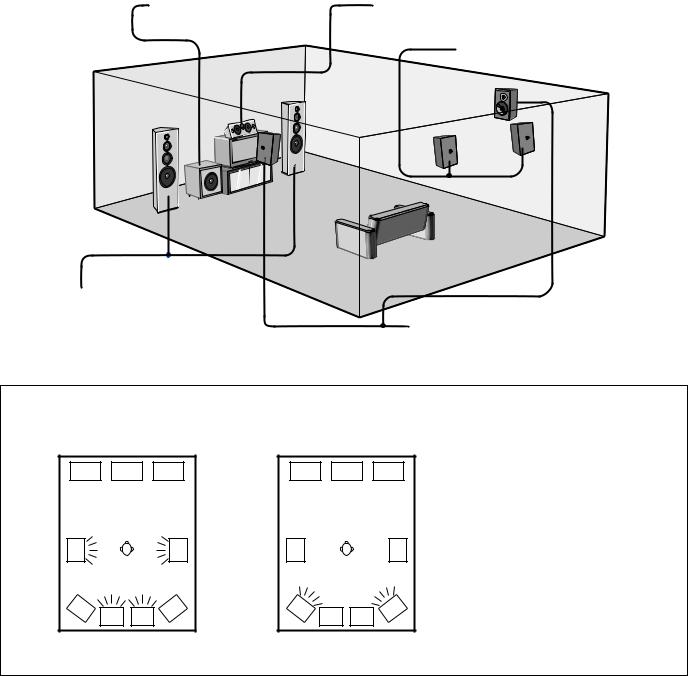
•Speaker system layout
Basic system layout
• The following is an example of the basic layout for a system consisting of eight speaker systems and a television monitor:
Subwoofer |
Center speaker system |
Surround back speaker systems
Front speaker systems |
|
|
Set these at the sides of the TV or screen with |
|
|
their front surfaces as flush with the front of the |
Surround speaker systems |
|
screen as possible. |
||
|
With the AVR-3801 it is also possible to use the surround speaker selector function to choose the best layout for a variety of sources and surround modes.
•Surround speaker selector function
This function makes it possible to achieve the optimum sound fields for different sources by switching between two systems of surround speakers (A and B).
•It is also possible to select surround speakers A+B, but we recommend using the more effective multi surround speaker system with the surround back speakers.
A |
|
|
A |
A |
|
|
A |
Effective surround sound for all types of |
|
|
|
|
signals sources can be selected with the |
||||
|
|
|
|
|
|
|
|
|
|
|
|
|
|
|
|
|
Surround back parameter settings. |
|
|
|
|
|
|
|
|
(For details, see page 50.) |
B |
A |
A |
B |
B |
A |
A |
B |
|
|
|
|
|
|
||||
|
Using A only |
|
|
Using B only |
|
|
||
(Multi surround speaker system) |
(Single surround speaker system) |
|
||||||
17
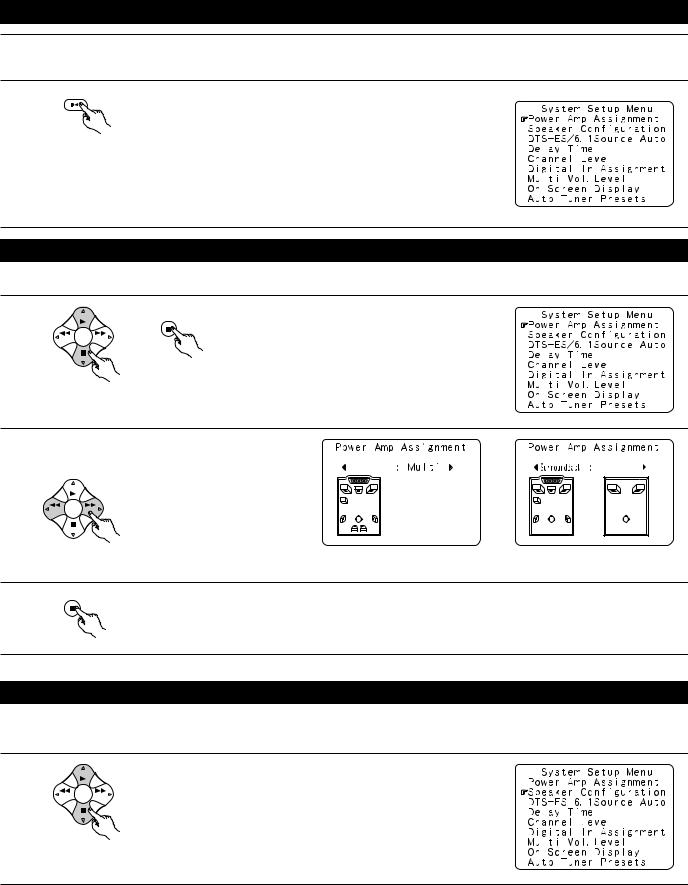
Before setting up the system
1 Check that all the connections are correct, then turn on the main unit’s power.
2 |
SETUP |
Display the System Setup Menu.
Setting the power amplifier assignment
Make this setting to switch the power amplifier for the surround back channel to Multi.
1 |
TUNING |
ENTER |
|
|
At the System Setup Menu, select “Power Amp Assignment” and press the ENTER button
BAND |
MODE |
SHIFT |
TUNING
2 |
Select “Surround Back” to use as the surround back |
|
||
channel, “Multi” to use as multi zone out. |
|
|||
|
|
|
|
|
TUNING
BAND
TUNING
When “Surround Back” is selected |
When “Multi” is selected |
3 |
ENTER |
SHIFT |
Enter the setting.
The System Setup Menu reappears.
Setting the type of speakers
•The composition of the signals output from the different channels and the frequency response are adjusted automatically according to the combination of speakers actually being used.
1 |
At the System Setup Menu select “Speaker Configuration”. |
|
|
|
TUNING |
BAND |
MODE |
|
TUNING |
18
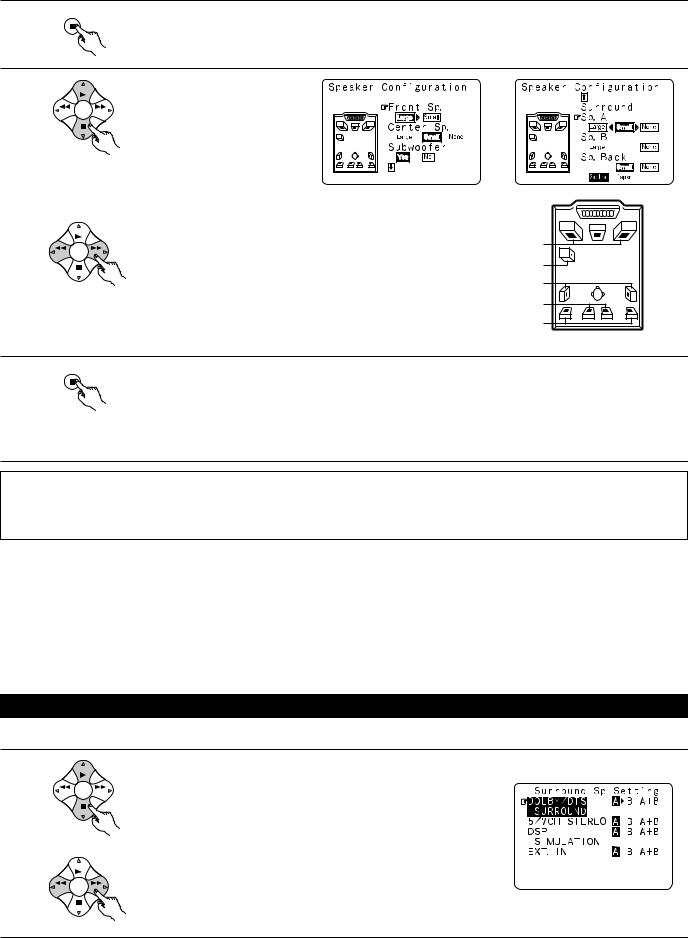
2
3
4
ENTER |
Switch to the speaker configuration screen. |
SHIFT |
|
|
Set whether or not speakers are |
TUNING |
connected and, if so, their size |
|
|
|
parameters. |
BAND |
MODE |
|
• To select the speaker |
TUNING |
|
|
|
|
|
|
|
|
|
|
|
• To select the parameter |
|
Center Sp. |
|
|
|
|
|
||
|
|
|
|
|
|
||||
|
|
|
|
|
|
||||
|
|
|
|
|
|
||||
|
|
|
|
|
|
||||
|
|
|
|
||||||
|
|
||||||||
TUNING
Front Sp.
BAND
Subwoofer
TUNING
Surround Sp. A
Surround back Sp.
Surround Sp. B
ENTER |
Enter the setting. |
|
a) If no surround speakers are used (if “None” is set for both A and B): |
SHIFT |
The Subwoofer Mode screen appears. |
b)If both surround speakers A and B are used (if either “Large” or “Small” is set for both A and B): The surround speaker setting screen appears.
c)If “None” is set for surround speakers A:
“None” is automatically set for surround speakers B and surround back.
NOTE:
•Select “Large” or “Small” not according to the actual size of the speaker but according to the speaker’s capacity for playing low frequency (approximately 80 Hz and below) signals. If you do not know, try comparing the sound at both settings (setting the volume to a level low enough so as not to damage the speakers) to determine the proper setting.
•Parameters
Large…… Select this when using speakers that can fully reproduce low sounds of below 80 Hz.
Small…… Select this when using speakers that cannot reproduce low sounds of below 80 Hz with sufficient volume. When this setting is selected, low frequencies of below 80 Hz are assigned to the subwoofer.
None…… Select this when no speakers are installed.
Yes/No…. Select “Yes” when a subwoofer is installed, “No” when a subwoofer is not installed.

 If the subwoofer has sufficient low frequency playback capacity, good sound can be achieved even when “Small” is set for the front, center and surround speakers.
If the subwoofer has sufficient low frequency playback capacity, good sound can be achieved even when “Small” is set for the front, center and surround speakers.

 For the majority of speaker system configurations, using the SMALL setting for all five main speakers and Subwooofer On with a connected subwoofer will yield the best results.
For the majority of speaker system configurations, using the SMALL setting for all five main speakers and Subwooofer On with a connected subwoofer will yield the best results.
Selecting the surround speakers for the different surround modes
• At this screen preset the surround speakers to be used in the different surround modes.
1 |
TUNING |
BAND |
MODE |
|
TUNING |
|
TUNING |
BAND |
|
When either “Large” or “Small” has been set for both speakers A and B on the System Setup Menu (when using both A and B surround speakers), the surround speaker setting screen appears.
Select the surround speakers to be used in the different surround modes.
•To select the surround mode
•To select the surround speaker
A:When using surround speakers A
B:When using surround speakers B
A+B: When using both surround speakers A and B
TUNING
19
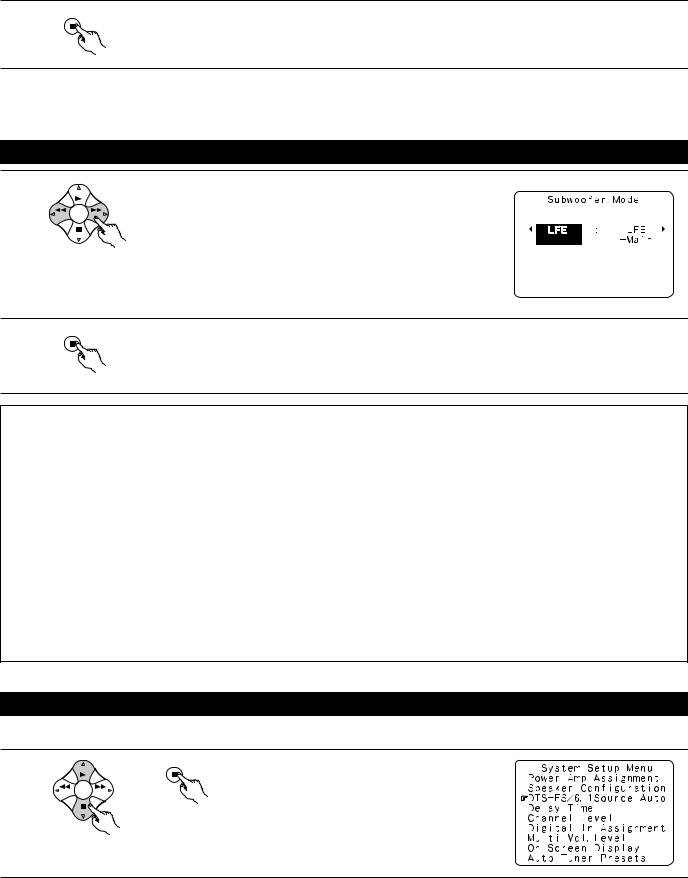
2 |
ENTER |
SHIFT |
Enter the setting.
When “Front” is set to “Large” and “Subwoofer” is set to “Yes”, the set switches to the subwoofer mode.

 Speaker type setting when using both surround speakers A and B
Speaker type setting when using both surround speakers A and B
If “Small” is set for either surround speakers A or B, the output is the same as when “Small” is set for both A and B.
Setting the Subwoofer mode
1 |
Select the Subwoofer mode. |
|
|
|
TUNING |
|
BAND |
|
TUNING |
2 |
ENTER |
SHIFT |
Enter the setting.
The System Setup Menu reappears.
NOTES:
— Assignment of low frequency signal range —
• The only signals produced from the subwoofer channel are LFE signals (during playback of Dolby Digital or DTS signals) and the low frequency signal range of channels set to “SMALL” in the setup menu. The low frequency signal range of channels set to “LARGE” are produced from those channels.
— Subwoofer mode —
•The subwoofer mode setting is only valid when “LARGE” is set for the front speakers and “YES” is set for the subwoofer in the “Speaker Configuration” settings (see page 18).
•When the “LFE+MAIN” playback mode is selected, the low frequency signal range of channels set to “LARGE” are produced simultaneously from those channels and the subwoofer channel.
In this playback mode, the low frequency range expand more uniformly through the room, but depending on the size and shape of the room, interference may result in a decrease of the actual volume of the low frequency range.
•Selection of the “LFE ” play mode will play the low frequency signal range of the channel selected with “LARGE” from that channel only. Therefore, the low frequency signal range that are played from the subwoofer channel are only the low frequency signal range of LFE (only during Dolby Digital or DTS signal playback) and the channel specified as “SMALL” in the setup menu.
•Select the play mode that provides bass reproduction with body.
•When the subwoofer is set to “Yes”, bass sound is output from the subwoofer regardless of the subwoofer mode setting in surround modes other than Dolby/DTS.
Setting the DTS-ES/6.1 Source Auto
Set the operation for the digital signals when playing in the 6.1 SURROUND and DTS-ES surround modes.
1 |
ENTER |
TUNING |
|
SHIFT |
At the System Setup Menu select “DTS-ES/6.1 Source Auto” and press the ENTER button.
BAND MODE
TUNING
20
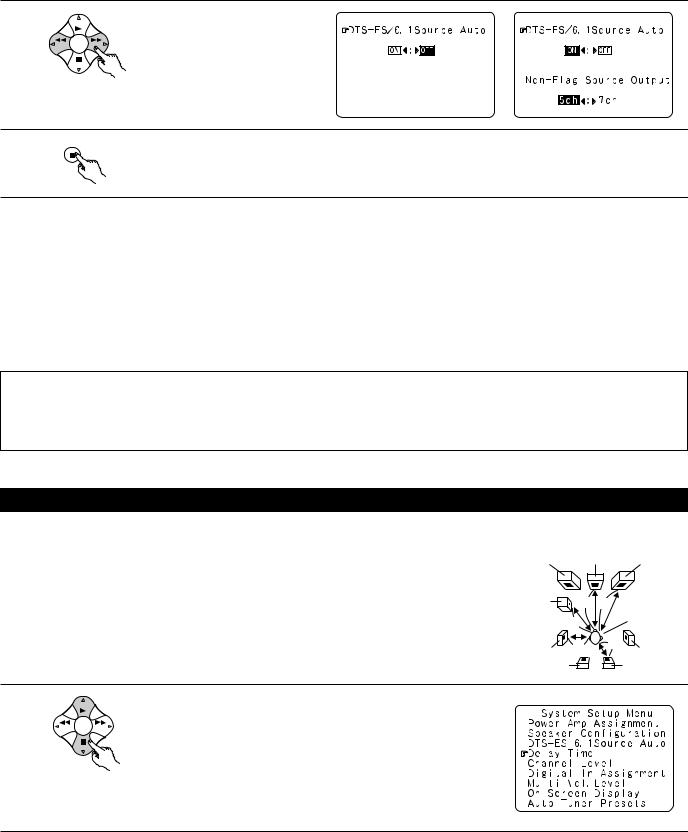
2
3
Select the desired setting.
TUNING

 We recommend setting this to
We recommend setting this to
BAND
|
“OFF”. |
TUNING |
When set to “ON”, the |
|
operation for software for which |
|
no identification signals are |
|
recorded is set. |
ENTER |
Enter the setting. |
|
The System Setup Menu reappears. |
SHIFT |
|
Setting |
|
OFF............ |
Set the “OFF” mode to perform 6.1-channel playback with conventional 5.1-channel sources or sources on which the |
|
identification signal described below is not recorded. |
ON ............. |
This function only works with software on which a special identification signal is recorded. This software is scheduled to go on |
|
sale in the future. |
|
This is a function for automatically playing in the 6.1-channel mode using the surround back speakers if the software is recorded |
|
in 6.1 Source or DTS-ES or in the normal 5.1-channel mode without using the surround back speakers when the software is not |
|
recorded in 6.1 Source or DTS-ES. |
5 ch............ |
Playback is conducted without using the surround back speaker. |
7 ch............ |
Playback is conducted using the surround back speaker. The same signals as those of the surround channels are output from the |
|
surround back channel. |
NOTES:
•The “DTS-ES/6.1 Source Auto” setting screen is displayed when the surround back speaker is set to “Large” or “Small” at “Speaker Configuration”.
•The surround back speakers can also be turned on and off using the “6.1/7.1 Surround” surround parameter. (See page 51.) Select the setting according to the program source to be played.
Setting the delay time
•Input the distance between the listening position and the different speakers to set the delay time for the surround mode.
•The delay time can be set separately for surround speakers A and B.
Preparations:
Measure the distances between the listening position and the speakers (L1 to L5 on the diagram at the right).
L1: Distance between center speaker and listening position L2: Distance between front speakers and listening position L3: Distance between surround speakers and listening position
L4: Distance between surround back speakers and listening position L5: Distance between subwoofer and listening position
FL |
Center |
|
FR |
Subwoofer |
L1 L2 |
|
|
|
L5 |
|
Listening position |
|
|
|
|
SL |
L3 |
L4 |
SR |
|
|||
SBL |
|
|
SBR |
1 |
At the System Setup Menu select “Delay Time”. |
|
|
|
TUNING |
BAND |
MODE |
|
TUNING |
21
